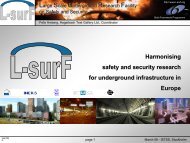Tunnel explosion characteristic - istss
Tunnel explosion characteristic - istss
Tunnel explosion characteristic - istss
You also want an ePaper? Increase the reach of your titles
YUMPU automatically turns print PDFs into web optimized ePapers that Google loves.
<strong>Tunnel</strong> Explosion Characteristics<br />
Rickard Forsén<br />
FOI Swedish Defence Research Agency<br />
Defence and Security Systems and Technology, Tumba, Sweden<br />
Introduction<br />
Examples of applications<br />
Characteristics ot tunnel <strong>explosion</strong>s<br />
Possible risk reduction measures
Introduction<br />
Explosion <strong>characteristic</strong>s:<br />
Sudden increase in volume and release of energy<br />
Creating:<br />
High pressure/shockwave<br />
Usually generation of:<br />
High temperature<br />
Release of gases<br />
May result in:<br />
High velocity fragments
Introduction<br />
Example of consequences of tunnel <strong>explosion</strong>s:<br />
Local effects:<br />
Extremely high pressure<br />
Cratering, spalling, punching, debris throw<br />
Damage to structures above tunnel covering<br />
Distant effects inside tunnel:<br />
Damage to separating/dividing structures, vehicles, humans<br />
Outside adits:<br />
Jets<br />
Heat from fire ball
Introduction<br />
Example of scenarios:<br />
Dangerous goods accidents with:<br />
Hazard division 1 – high explosive substances and products<br />
Hazard division 2 – inflammable gases<br />
Hazard division 5 - oxidizing agents<br />
Antagonistic acts of <strong>explosion</strong><br />
Briefcase/suitcase bombs<br />
Car bombs (sedans .. vans .. trucks)
Examples of application<br />
Shock tubes: - experimental arrangement for well defined testing<br />
1.6 m<br />
1.5 m<br />
2<br />
1<br />
3<br />
10 m<br />
4
Examples of application<br />
Fortifications<br />
Blast propagation<br />
in tunnel systems
Underground Ammunition Storage<br />
Examples of application<br />
Scale 1:3<br />
Debris<br />
Chamber<br />
Traps<br />
30 x 9 x 4 m<br />
Main <strong>Tunnel</strong><br />
Main<br />
<strong>Tunnel</strong><br />
100 x 15 m 2<br />
Access <strong>Tunnel</strong><br />
Access<br />
170 x 8 m 2 <strong>Tunnel</strong><br />
Debris<br />
Trap<br />
Slot<br />
<strong>Tunnel</strong><br />
Detonation<br />
Chamber<br />
Old Klotz <strong>Tunnel</strong><br />
Entrance<br />
Portal<br />
Barricade<br />
TEST FACILITY LAYOUT
Examples of application<br />
Underground<br />
Ammunition<br />
Storage<br />
Test with<br />
10 tons of<br />
high explosive<br />
Test 4b
Examples of application<br />
At tunnel exits:<br />
A long-duration jet and<br />
a short-duration shock wave
Examples of application<br />
Calculations with AUTODYN - Jet hitting simulated<br />
building 100 m in front of adit<br />
10 ton 40 ton
Characteristics<br />
250 m tunnel length, 4 m 2 tunnel area, 50 kg HE
Examples of application<br />
Buildings above tunnels with<br />
dangerous goods transports
Antagonistic threats<br />
Examples of application
Overpressure (kPa)<br />
Characteristics<br />
High explosives detonations in tunnels:<br />
considerably higher pressure<br />
considerably longer duration<br />
10000<br />
1000<br />
16 000 kg in 50 m2 tunnel<br />
100<br />
400 kg in 50 m2 tunnel<br />
400 kg in free air, surface burst<br />
10<br />
1<br />
10 100 1000 10000 100000<br />
Stand off (m)<br />
16 000 kg in free air, surface burst<br />
Parameters of the<br />
tunnel affecting the<br />
pressure attenuation<br />
are:<br />
- Length of tunnel<br />
and standoff from<br />
<strong>explosion</strong> to target<br />
- Cross section area<br />
of the tunnel<br />
- Roughness/friction<br />
of the walls<br />
- Turns of tunnel<br />
direction and area<br />
changes etc.
Characteristics<br />
Gas <strong>explosion</strong>s in tunnels:<br />
High burning velocities due to confinement and turbulence
Possible countermeasures<br />
1. Exclude high explosives and other potentially<br />
exploding substances from tunnels<br />
Certain dangerous goods transports forbidden entirely or<br />
allowed only on limited occasions - disadvantages in that<br />
the risks for the alternate routes may be higher to the<br />
society as a whole.<br />
Detection of, for example, high explosives (antagonistic<br />
threats) - difficult challenges are fast detection and at<br />
significant standoff distances
Possible countermeasures<br />
2. Automated systems with blast energy absorbers<br />
(for example water mist) initiated with sensors to<br />
detect an <strong>explosion</strong><br />
Lack of reliability of blast identification<br />
Low speed of blast energy absorber activation<br />
Inadequate discharge of blast absorbing agent.
Possible countermeasures<br />
3. Design of structures inside the tunnel and at the<br />
adits, and above the tunnel to resist the load from<br />
<strong>explosion</strong>s.<br />
The most robust method of preventing unacceptable damage
Thank you, questions?















